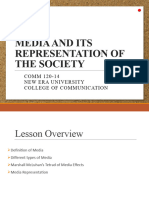01 Chapter 001-025
01 Chapter 001-025
Uploaded by
Steven EstradaCopyright:
Available Formats
01 Chapter 001-025
01 Chapter 001-025
Uploaded by
Steven EstradaOriginal Title
Copyright
Available Formats
Share this document
Did you find this document useful?
Is this content inappropriate?
Copyright:
Available Formats
01 Chapter 001-025
01 Chapter 001-025
Uploaded by
Steven EstradaCopyright:
Available Formats
ELECTRONIC MEDIA FORMS
Part
wide variety of electronic media exists for the dissemination of entertainment and information. Within less than the average
lifetime, these media have proliferated into more than a dozen forms. The media both complement and compete with one another, experiencing the slings and security of the free enterprise system. Some people wonder how many forms of media the market can bear; others marvel at how many it does bear. As these media develop, change is inevitable, brought about by both external and internal forces. Although all the media forms are relatively young, they are already rich in history and adaptation. The first chapter of this section deals with the significance of the various media; the succeeding chapters handle such media forms as the internet, portable devices, video games, broadcast TV, cable TV, satellite TV, home video, radio, and movies.
Chapter
THE SIGNIFICANCE OF ELECTRONIC MEDIA
ou would be hard-pressed in modern American society to find someone who does not
interact with electronic media on a daily basissomeone who does not surf the internet, watch TV, listen to the radio, download music to an iPod, go to a movie, play
Television is less a means of communication (the imparting or interchange of thoughts, opinions, and information by speech, writing, or signs) than it is a form of communion (act of sharing or holding in common; participation, association; fellowship).
Richard Schickel, The Urban Review
a video game, send an email, talk on a cell phone, watch a DVD. In fact, many people, in this age of multitasking, interact with several media at the same time. They watch a movie on a DVD while listening to music on an iPod, playing a video game, checking email, and telling a friend all about it over a cell phone. In addition, everyone has opinions that relate to media. Our opinions decide whether a movie or a TV series is a hit or a dud. We vote for our favorite
American Idol singer. We argue about the medias coverage of political candidates. We talk about the tactics used in commercials and the sex and violence seen on TV and heard in radio song lyrics. We worry about the predators on the internet and whether or not our cell phones will cause cancer. Parents and
Chapter 1
The Significance of Electronic Media
children clash over the amount of time the latter spend playing video games, watching TV, or text messaging. The media are constantly changing. Not very long ago there was no internet, no iPod, no Wii. Within the past few decades, a number of technologies that were highly touted have gone by the waysidesubscription TV, multichannel multipoint distribution service, teletext. The way people used electronic media and how they perceived the media were quite different ten years ago from what they are today.
1.1 A Rationale for Study
Even though everyone has a basic knowledge of the field of electronic media, there are many reasons to study it. Anyone who is aiming toward a career in this area will profit from an intimate knowledge of the history and organization of the industry. Those armed with knowledge have a greater chance for career survival than those who are naive about the inner workings and interrelationships of networks, stations, cable TV facilities, the internet, movie studios, advertisers, unions, telephone companies, the government, and a host of other organizations that affect the actions and programming of the industry. As the various forms of communications expand, they create new and exciting jobs (see Exhibit 1.1). Knowledge of the past will help people predict the direction of their future jobs. Knowing about media can also help practitioners set their own personal values so that they can help mold the industry into a form that they feel is effective in a positive way.
career options
Exhibit 1.1
The jobs pictured here were created recently when digital technologies allowed the number of cable TV channels to grow, and this network, TVG, was formed to specialize in horse racing.
(Courtesy of TVG)
Part 1 Electronic Media Forms
understanding
fascination
At a broader level, individuals owe it to themselves to understand the messages, tools, and communication facilities that belong to our society because they are so crucial in shaping our lives. Rare is the individual who has not been emotionally touched or repulsed by a scene in a movie. Rare, too, is the individual who has never formed, reinforced, or changed an opinion on the basis of information heard on radio or seen on TV or the internet. Knowledge of the communications industry and its related areas can lead to a greater understanding of how these forces can influence and affect both individual lives and the structure of society as a whole. It can also teach each individual the most effective methods for interacting with media and affecting programs and services. In addition, the electronic media are fascinating and worthy of study in their own right. Those in the field are associated with glamour and excitement (and power and greed), both on-screen and off. Although the day-to-day workings of the industry can be as mundane as they are in any other field, the fact that it is a popular art that includes the rich and famous makes this industry of special interest. The ramifications of the power that the electronic media exert over society are most deserving of study.
1.2 A Matter of Terms
Before embarking on a study of electronic media, it is wise to acquaint yourself with some of the terms related to the industry. Through the years the terms have changed in meaning and use, and new technologies bring forth new terms. You may be familiar with many of the terms listed in the following paragraphs; you will learn more about them and the terms you dont know in the remaining chapters of this book. The widespread study of radio, television, and film at the university level did not begin until the 1960s. At that time, film was considered to be separate from radio and television and often was not in the same department. Movies were a chemical medium, and films were projected only in theaters, not in homes. There were two electronic mediaradio and televisionand together they were called broadcasting. Radio consisted of a fairly large number of local stations with specific formats. Television was dominated by three commercial networksABC, CBS, and NBCand their affiliated stations. A few stations were independent and did not broadcast material from any of the three big networks, but they were considered second-class. By the late 1960s, broadcasting was divided into two categories commercial broadcasting supported by advertising and public broadcasting supported primarily by government funds and personal donations. These two coexisted harmoniously because public broadcasting was small and not a threat to its commercial kin. In fact, it often relieved commercial broadcasting of its more onerous public-service requirements because the commercial broadcasters could point out that public broadcasting, with its educationally oriented programming, served that interest. In the mid-1970s, a number of other media challenged radio and broadcast TV, creating an alphabet soup that included CATV (community antenna TV, which became known as cable TV), VCRs (videocassette recorders), DBS
1960s
1970s
Chapter 1
The Significance of Electronic Media
(direct broadcast satellite, later referred to as satellite TV), and LPTV (lowpower TV). Video games were becoming popular in arcades. Corporations began using television for training, referring to this as industrial TV; later the name was changed to corporate video or organizational TV because industrial sounded too grimy. The word broadcasting no longer seemed to apply because that word implied a wide dissemination of information through the airwaves. Many of these other media were sending information through wires, and cable TV was even touting its narrowcasting because its programs were intended for specific audience groups. The whole concept of television as a form of mass communication began to change during the 1980s. Before that, most people in the country watched the same programming at the same relative time. The three networks competed fiercely, but, on the average, each garnered almost 30 percent of the available audience. They were mass communication systems sending out programming to be viewed by generally passive masses. With the introduction of a variety of delivery systems, TV became a more fractionalized medium that appealed to smaller groups of consumers. No longer did three network programming chiefs call the shots on what people would watch and when they would watch it. People could videotape programs off the air to watch whenever they wanted, or they could visit the local video store and rent a movie, thus bringing the film industry into the electronic realm and enabling people to watch movies in their homes. Instead of watching NBC, CBS, or ABC, people could watch one of the many cable or satellite TV channels, the newly formed Fox network, public broadcasting, one of the independent TV stations, or one of the other alternative media forms. They could also use their newly invented remote controls to switch from one program to another anytime they became slightly dissatisfied, without taking a long walk from the easy chair to the TV set to change the channel. The share of audience that the big three networks had attracted plummeted dramatically (see Exhibit 1.2).1
1980s
The Prime-Time Share of Audience of ABC, CBS, and NBC from 1978 through 2006
100 90 80 Percent share 70 60 50 40 30 20 10 0 1978 1980 1982 1984 1986 1988 1990 1992 1994 1996 1998 2000 2002 2004 2006 Years
Exhibit 1.2 The share of audience of the original TV networks (ABC, CBS, and NBC) has dipped continuously since the advent of cable TV networks and other new technologies.
6 1990s
Part 1 Electronic Media Forms
2000s
In the 1990s, the field continued to broaden. Telephone companies developed the cell phone and also entered program distribution areas that had traditionally been reserved for broadcasters and cablecasters. The once lowly phone line allied itself with the computer and the modem, spawning a new array of digital interactive services, including electronic mail (email) and access to information provided on the internet. Although at first this information was provided only by text and rudimentary graphics, it did include news, stock market quotes, sports, and other information traditionally provided by radio and TV, as well as newspapers and magazines. By the mid-1990s, the internet was flexing its muscle to become a prime electronic media distribution system, and along with it came many new terms: webcasting, browsers, ISPs, search engines, blogging, chatrooms. On the home video front, DVDs began replacing analog VCRs. As digital technology improved in the 21st century, so did the quality and quantity of internet offerings. High-speed (broadband) modems, offered by phone companies and cable TV companies, and larger-capacity hard drives accommodated improved graphics, audio, and video. Anyone, not just the powerful networks, could place program material on the internet that could be accessed by anyone else connected to the internet. High-quality cameras became so portable and inexpensive that individuals could use them (and their lower-quality cell phone cameras) to produce material. The passive masses became interactive individuals. In addition, digital video recorders (DVRs), commonly known as TiVos, made it easier for people to record TV programs and watch them when and how they want. Satellite radio (originally called digital audio radio service, or DARS) allowed for radio programming that could cover the entire nation, and terrestrial radio stations started switching from analog to HD radio, also known as in-band on-channel (IBOC). Television outlets switched from analog to digital and began emphasizing high-definition TV. The DVD industry adopted a new high-definition format, and movie theaters started switching from film projection to electronic based digital cinema. Apple introduced the iPod, and podcasting entered the vernacular. Cell phones, pods, MP3 players, and PDAs became additional avenues for accessing and using the internet and also brought forth concepts such as text messaging. In addition, internet sites arose that enabled individuals to engage in social networking. The terms will not stop coming. As technology improves, companies will invent new ways to enhance media. The one element that runs through all the terms listed and all the ones to come is the need for content. Regardless of the delivery system, there must be something worth delivering. There will always be a need for good storytelling and for engaging methods of presenting information.
1.3 Ownership of Media Devices
Statistics and studies tell us a great deal about the relationship of people and society to the electronic media. Americans own a large number of electronic communication devices (see Exhibit 1.3). However, there have been a number of significant shifts in ownership recently.2
Chapter 1
The Significance of Electronic Media
Percentage of American Households with Various Electronic Media Devices and Services
Radios TV sets Cable TV Satellite TV Phone company TV Landline phones Cell phones Internet access Video game consoles VCRs DVDs DVRs PDAs MP3 players Camcorders Home theater sound 0 20 36 40 60 80 100 Percent of households 18 28 55 24 41 79 81 76 85 10 96 25 61 99 99
Exhibit 1.3 Americans own many devices that help them keep entertained, informed, and connected. How many of these do you own?
Internet access, which didnt even register on the charts until the 1990s, has grown at a phenomenal rate and should soon qualify as a universal service. Cell phone penetration continues to grow while landlines, which were almost 100 percent for many years, are shrinking. The reason is fairly obviousthe recent trend for people to use their cell phones as their only phones, eliminating the need for a phone attached to a home base. The chart shows households with cell phones, but there is a definite trend for multiple people within one household to own phones. In fact, there currently are more cell phones than people in the United Statesas well as in many other countries. Cable TV penetration is down, having at one point reached 70 percent. This is due in part to the rise in satellite TV subscribers, and some households have switched to a new source for their TV signalsFiOs provided by Verizon telephone company. Studies show that 96 percent of people are satisfied with the TV service given by the phone company, 86 percent are satisfied with satellite, while only 71 percent are satisfied with cable. No doubt this discontent is part of the reason for cable TVs decline. VCR penetration is down from about 90 percent to 79 percent and many of the 79 percent are probably units people still have but rarely use. Households have switched to DVDs, which have superior quality. The number of households with high-definition DVDs is too small to measure, but that may be something that increases in the future.
internet and phones
cable, satellite, and FiOs
VCRs and DVDs
8 video games and DVRs
Part 1 Electronic Media Forms
radio and TV
The percentage of homes with video game consoles has grown about 8 percent from the beginning of the 21st century to over 40 percent. A single household may have multiple consoles, and people frequently buy new models. The number of digital video recorders is growing at a rapid rate, allowing more people to shift their viewing to when they want it rather than when it is aireda phenomenon that is becoming known as me TV. The two most stable and pervasive media devices are radios and TV sets. They remain at close to 100 percent penetration, where they have been for many years. The average household owns 6 radios and 2.4 TV sets.
1.4 Use of Electronic Media
Of course, people dont just own these electronic media devices; they use them. Studies show that people spend an average of 3 hours a day online, 3 hours listening to radio, and 4.5 hours watching TV. The fact that people multitask means that this does not add up to 10.5 hours a day of electronic media use. The best guesstimate is that people, on average, spend a little over 4 hours a day with radio, TV, and the internet, but that does not include the amount of time people talk on the phone, play video games, or go to the movies. Regardless what the exact number is, people spend a great deal of time with media, making it a very significant part of their lives. Interestingly, although many people thought the internet would cut down on the amount of time people spent watching TV, this apparently has not been the case. In fact, in one survey, more heavy internet users said their TV viewing had gone up than said it had gone down. The number of hours that the TV set is on in the average household has remained stable (see Exhibit 1.4), although there has been a definite trend away from viewing broadcast television (NBC, CBS, ABC, Fox, etc.) to watching cable TV (MTV, USA, Lifetime, ESPN, etc.). Watching TV is becoming a complicated concept because people can watch traditional TV
hours spent
internet and TV
Exhibit 1.4 The number of hours that the TV set is on continues to grow, but at a slower rate than in the past.
Hours
Average Hours a TV Set Is On in Households
8 7 6 5 4 3 2 1 0 1955 1965 1975 Years 1985 1995 2005
Chapter 1
The Significance of Electronic Media
9 Exhibit 1.5 Sales of video game software and hardware took a jump in 2007.
Video Game Sales
18 16 Billions of dollars 14 12 10 8 6 4 2 0 2002 2003 2004 Years 2005 2006 2007
programs on the internet and can also watch programming fare that is being created specifically for the internet.3 Video games are an area of growth, with the amount of money spent on game software and hardware spiking in the mid-2000s (see Exhibit 1.5). Grand Theft Auto IV grossed $500 million in its first week of sales in 2008, and the Wii accessories rack up sales and profits. Video games have become a bigger industry than domestic movies.4 Since 2003, the Online Publishers Association in cooperation with Nielsen/ Net Ratings has measured internet use in terms of categories: commerce, communications, community, content, and search (see Exhibit 1.6). Commerce includes
video games
internet categories
Average Time Spent on Online Activities
20032004 20062008 Key Content Search Commerce Communications Community
Exhibit 1.6 This chart shows some of the changes that have occurred in online activities between 2003 and 2008.
10
Part 1 Electronic Media Forms
online shopping at such sites as amazon.com, eBay, and shopping.com. Communications originally just meant email but now also includes instant messaging and some types of group communication. Community was not added until 2008; it refers to sites such as Facebook and MySpace that combine user-generated content with communications in order to foster relationships. Content involves sites that provide news, information, and entertainment, such as MapQuest, ask.com, and CNN.com. Search means using the internet to look for material by requesting certain information; examples would be Google and Yahoos search engine. The most interesting change between 2003 and 2008 was the exchange of position between content and communications. Whereas communication was first (44 percent) and content second (36 percent) in 2003, by 2008 the numbers had almost reversed, with content at 43 percent and communication at 30 percent. This change may be due, on the one hand, to a dramatic increase in content of a reliable nature on the internet and, on the other, to the movement of some communication to the category of community.5 In general, people like the electronic media. Only 6 percent of people would even consider giving up television or the internet. Younger people are more likely to prefer the internet over TV, but many also report watching TV and surfing the internet simultaneously (see Zoom In box).
ZOOM IN: Extra Credit
For those of you who like statistics, here are a few other miscellaneous facts about the electronic media. 1. More than 50 percent of teens do not buy any CDs; they download, mostly from iTunes. 2. Within the last 24 hours, about 75 percent of the population will have listened to radio and 90 percent will have watched TV. 3. Between 2006 and 2007, people reduced their time spent with broadcast TV and newspapers by 6.3 percent and increased their time spent with cable TV and video games by 19.8 percent. 4. In 2002 Monsters, Inc. became the first movie to sell more DVDs (7 million) than VHS tapes (4 million). DVDs have outsold VHS tapes ever since. 5. Of people who have broadband access to the internet, 30 percent view live streaming video, 20 percent watch saved video files, and 46 percent have listened to online radio. 6. Women are more likely than men (47 percent to 43 percent) to be concerned about the quality of material downloaded to portable devices. 7. Some 89 percent of teens say the internet and portable devices make their life easier; 71 percent of their parents agree. Can you explain these facts? Also, why do you think the internet apparently has not affected TV viewing? To what do you attribute the fact that content is now the leading use of the internet?
Chapter 1
The Significance of Electronic Media
11
1.5 The Functions of Media
Several decades ago, theoreticians claimed that the main functions of media were to entertain, inform, and persuade. As electronic media expanded and became more important to the social fabric, so did their functions. Today one way to look at the functions is to consider that the electronic media are involved with (1) presenting entertainment, (2) disseminating news and information, (3) aiding commerce, (4) transmitting culture and customs, (5) acting as a watchdog, (6) providing relaxation and companionship, and (7) connecting people to each other. These purposes are not mutually exclusive. It is entirely possible that one television program, for example, could serve all these functions.6
1.5a Presenting Entertainment
list of functions
Entertainment occupies the lions share of time or space for many forms of electronic media. Movies, for example, are almost totally entertainment based, as are video games. Approximately three-fourths of the programming on TV qualifies as entertainment; for radio stations with a music format, the percentage is even higher. The internet started out delivering primarily information, but in recent years its capacity to deliver audio and video has improved, and now many people use the internet for entertainment purposes. Portable devices, such as an iPod filled with music, also provide entertainment. Electronic media provide so much entertainment because that is what people seem to want. Ratings for dramas are almost always higher than ratings for documentaries. Individuals, however, certainly have the ability to choose not only how much entertainment they want, but also what type of entertainment they desire. Sports fans can always find something on some medium devoted to sports, and even a group as narrow as Law and Order aficionados can get their fill by using broadcast TV, cable TV, DVDs, internet downloads, and other media forms. For many years entertainment was a passive activity; people watching TV were often referred to as couch potatoes because they just sat on their couches and watched what someone else produced. Today watching passively is still the major mode for entertainment, but there are more opportunities than ever before for active participation in entertainment. Anyone can set up a website to program audio or video material. Sites such as YouTube, MySpace, and Facebook encourage people to program their own creative ideas. Some movies allow viewers to select the ending, and the user has great control over how video games progress. The media do not always fulfill their entertainment function to the satisfaction of everyone. Politicians, citizens groups, parents, and others complain about the amount of sex and violence in TV programs, movies, and music lyrics on the radio. Although the electronic media do provide excellent entertainment, some of it is trite or just plain bad. When some idea catches on for one network, others quickly imitate it, and the imitations are usually not as good as the original. Some
major function
options
passivity
12 criticisms
Part 1 Electronic Media Forms
believe that this is particularly true of the reality genre. Started because it was inexpensive, it has now spawned across many networks. However, entertainment will no doubt continue to be the dominant function of electronic media. People like to be entertained, and the electronic media are well equipped to provide entertainment.7
1.5b Disseminating News and Information
Although entertainment may rank as the top function of electronic media in terms of quantity and accessibility, there are many times when the importance of news or information transcends anything of an entertainment nature. When routine there is a terrorist attack, a fire, a tornado, or some other imminent danger, peoinformation ple turn to the media. This certainly happened on September 11, 2001, when terrorists crashed airplanes into the World Trade Center (see Exhibit 1.7); internet sites were overloaded, and people were glued to their TV sets. Radio is particularly valuable in emergency circumstances because most people have battery-operated radios that continue to work when other media do not. This happened when Hurricane Katrina hit New Orleans in 2005; other media forms failed, but radio stations stayed on the air. The telephone also becomes important, especially now that emergency agencies can use reverse 911 to call many people to give them information. During the 2007 Virginia Tech shootings, students kept in touch with each other and exchanged information through cell phones and internet blogs.8 It does not take an emergency for the information function to be valuable, however. If you want to know whether to carry an umbrella or what route you should take to work, the media can instruct you. They can also provide the latest economic information (unemployment statistics, stock market results), as well as information about the media (whats playing at the local theater, whats on TV tonight). During political campaigns, most people learn about the candidates through the media. Both radio and television are valuable for providing useful general information, but the internet is proving even more valuable Exhibit 1.7 because the information you need is always available. The electronic media were instrumental in disYou dont have to wait for your radio or TV station to seminating the news of the terrorist attacks on broadcast the weather; you can access your favorite the New York World Trade Center on September internet weather site and obtain the information 11, 2001. instantaneously. (Amy Sancetta/AP Wide World) Most people like to stay up-to-date on the news of the day, and the electronic media provide ways of
importance
Chapter 1
The Significance of Electronic Media news
13
doing that. For many years, the broadcast network evening news was the main source of news for many people. Those newscasts still lead in number of viewers, but the numbers have eroded greatly from the 1980s as audience members have turned to cable TV 24-hour-a-day news services, all-news radio, the internet and The Daily Show with Jon Stewart (see Zoom In box).9 In addition to information that you need, the media also provide information that is interesting but not crucial. Although you can get through life without knowing about the mating patterns of the cockroach, a well-presented chronicle on the subject can convey provocative, and sometimes useful, information. Many TV channels provide informational programming ranging from cooking shows to science experiments to history reenactments, and the amount of information available on the internet is growing exponentially. People who use the internet for news can take an active role by personalizing their internet pages with news stories from around the world that contain specific
noncrucial information
personalized news
ZOOM IN: News and The Daily Show
Rumors (and some research results) indicate that college-age people are using The Daily Show as one of their main sources of news. To oldsters, it seems preposterous that anyone would use a frothy comedy show that pokes fun at the news as an actual source for learning about the news. Jon Stewart himself admits that he is a not a journalist but rather a comedian. However, several researchers from Indiana University conducted an academic study comparing coverage related to the 2004 presidential debates and conventions on The Daily Show and on the broadcast networks nightly newscasts. They looked at NBC, CBS, and ABC newscasts and The Daily Show on specific days in July, August, and September when this subject was covered on all the programs. They then coded the material in terms of seconds devoted to hype (horse-race comments and hoopla), substance (campaign issues and candidate qualifications), and humor (joking and laughter). What they found was that the network shows had more hype than substance and The Daily Show had more humor than substance, but the amount of substance on both was the same. In other words, The Daily Show had just as much substance as the network newscasts. Do you watch The Daily Show? If so, do you look at it as a source of news? Would you consider The Daily Show to be an example of how program material can be both entertaining and informative?
Jon Stewart of The Daily Show.
(Courtesy of the Academy of Television Arts and Sciences)
14
Part 1 Electronic Media Forms
criticisms
words or phrasesEgypt, SAT scores, bipolar disorder. Some services automatically email you on a portable device such as a BlackBerry any time there is a new story with the words or phrases you have indicated. There are many complaints about news and information, ranging from its boring to its sensationalized. Because news departments of media entities need to make money, they sometimes resort to titillating stories that will attract audience members rather than hard news. Reporters dont always get it right. In the effort to be fast, they sometimes broadcast incorrect information. Often news is capsulated, with very little content for any one story. Most people think the news is biasedagainst whatever their point of view is. On the other hand, there are so many news venues now that individuals can find some source that agrees with their political leanings and thus can avoid being exposed to the views of othersa danger in a democracy. Documentaries become controversial when they present a point of view while programs that are purely informational, such as nature shows, do not attract a large audience. Although there is a great deal of information on the internet, anyone can place it there, so its accuracy is suspect.10
1.5c Aiding Commerce
persuasion
humor and effects
tailoring
shopping
Like it or not, advertising is a major part of the electronic media business. In the past, advertising was considered part of the persuasion function of the media because commercials were geared primarily to persuade consumers to buy products. Advertisers still hope purchases will be the outcome of most commercials, but commercials have changed, and the media now aid commerce in other ways. Research has shown that humor is effective in helping people remember commercials and the products they advertise. Also visual effects have improved greatly from what they were in the early days of electronic media. As a result, some commercials are not as hard sell as they used to be; they may contain only a short reference to the product while emphasizing humor and effects. Another trend is to match consumers with products that interest them. In some cable TV service areas, not everyone sees the same ads; they are tailored to the demographics of a particular area, and switching equipment at the cable headquarters sends different ads to different homes. Google has made important inroads into matching consumers and advertisers. When you type in the name of a product, the screen displays places where you can buy that product. Companies have paid to have their links included, but generally these links are helpful to the person doing the search, and they are unobtrusive. Media, the internet in particular, enable commerce between individuals through sites such as eBay and craigslist that help people sell possessions they no longer want (such as a 1972 encyclopedia) or find people to provide services they desire (such as walking a dog). The internet has also changed shopping patterns. Many people order products through the internet without setting foot in a store; the products are delivered to their homes via one of the truck delivery services. Some products, such as music, are delivered over the internet and do not involve any form of conventional transportation.
Chapter 1
The Significance of Electronic Media
15 gaining attention
In many ways, advertisers need to work harder to gain the attention of potential customers. People with DVRs easily skip through commercials, and the clutter of commercials on radio and TV means that any one commercial can get lost in the crowd. Advertisers have responded, in part, by placing their products within TV programs, movies, and video games, a practice known as product placement. They also create entire programs about single products (infomercials) or multiple products (home shopping channels). Hardly anyone will admit to liking commercialsexcept, perhaps, the ones that accompany the Super Bowl. Commercials can be loud, irritating, and deceptive. They are particularly controversial when aimed at young children who are not sophisticated enough to sort out the hype. They are so numerous that they really dont aid commerce; viewer fatigue sets in by the time the fourth ad in a commercial break airs. Some people take offense at the personal products that certain networks and stations air, such as feminine hygiene and condoms. Companies are constantly rethinking their marketing strategies, hoping that new ideas will be more acceptable and more productive. Any changes they make are likely to involve the electronic media in a major way.11
1.5d Transmitting Culture and Customs
criticisms
The electronic media transmit culture and customs without even trying. A TV program about lifestyles of the rich and famous may not show the customs most Americans are used to, but it does show a slice of Americana. American sitcom mothers are usually portrayed as loving, cheerful, and devoted to their children cultural values held high for mothers. A home show such as Martha Stewart Living conveys a message about what constitutes the good life. A documentary about Ethiopia details that country, but if that documentary is made by a French company, it may have a slant that reflects France as much as Ethiopia. A dramatic movie about ancient China will reveal the history and customs of that time, but will no doubt also reveal traits of modern times. People talking on cell phones convey their attitudes and values. The music that pours from an iPod is part of culture. Sometimes the transmitting of culture and customs is intentional. Spanishlanguage networks, Vietnamese-language stations, and similar entities have as part of their mission transmitting the values of the culture related to their languages. Religious programming is intent on disseminating the beliefs of a particular religion. Public service campaigns often try to enforce or change customsfasten your seat belt, dont smoke, dont drink and drive. People who interpret the news, such as conservative radio talk show hosts, liberal TV commentators, or bloggers, are trying to transmit their ideas of what society should be like. By transmitting culture and customs, people involved with the media also create stereotypes and give false impressions. Sitcoms, in order to garner a laugh, often exaggerate negative traits of a particular group of people. A movie that casts a particular minority as villains can be accused of creating a false stereotype. If programming from one culture is shown in another culture, this can result in culture clash. Governments have tried (largely unsuccessfully) to
unintentional
intentional
criticisms
16
Part 1 Electronic Media Forms
prevent programming from reaching their citizens because it shows customs that are not accepted in that country. Leaders in poor countries worry that if their citizens see lifestyles and customs of wealthier countries, they will become discontent and dissatisfied with the leaders.12
1.5e Acting as a Watchdog
politicians
election campaigns interpretation
In the United States, one of the functions of the media is to watch over aspects of society, particularly the government. Media have a responsibility to report defects, not ignore them. Most of this watchdog function falls to journalists. They keep a close eye on the actions of politicians and report indiscretions large or small. Sometimes this reporting creates an adversarial relationship between the government and the press. This is not the case in many other countries; in other societies, the press is a public relations arm of the government and primarily keeps people informed about the good things the government is doing for them. During election campaigns, the American press reports on the candidates and the election process, informing people so that they can make more intelligent voting decisions (see Exhibit 1.8). As part of their watchdog function, journalists also interpret. For example, after the president gives a speech, they tell us what the most important points were. They try to explain why the price of gasoline is rising or why unemployment is on the increase. Sometimes various media entities just present material and let members of the public draw their own conclusions. C-SPAN, for example, cablecasts the
Exhibit 1.8
The media covered all aspects of the 2008 election campaign.
Chapter 1
The Significance of Electronic Media
17
proceedings of various government bodies, including the House of Representatives. People can watch, without commentary from journalists, and make their own observations. On the internet are political sites of every flavor that people can examine to form (or reinforce) their points of view. The government is not the only body that the media watch over. They keep an eye on business, reporting misuse of funds and executive improprieties. The media also report on failures and successes in education, recreation, religion, and other aspects of society. The people being watched do not look favorably upon the watchdog function of the media. They feel they are being treated unfairly by overzealous journalists looking to blow any minor indiscretion into a major story. Some people who might make good public servants will not enter politics because they do not want to put themselves and their families through the brash scrutiny of the press.13
1.5f Providing Relaxation and Companionship
public conclusions
criticisms
Electronic media can fulfill the function of providing relaxation and companionship just by being there. For example, TV can be an excellent companion for older people who live alone. A simple turn of a radio switch can bring you relaxing music. Some people find relaxation in sorting through their email, playing video games, or talking to friends on the phone. Part of the reason that media can be relaxing is that they provide vicarious experiences. After a hard day at work, many people want to forget their own problems and become wrapped up in the lives of fictional characters whose problems far surpass theirs. Vicarious experiences can also serve as a release from boredom, or they can simply help pass the time. They can serve as an emotional release. Horror movies allow people to scream in a theater, and tear-jerkers allow them to cry without other people looking at them strangely. To some, relaxation is a synonym for laziness, and they do not buy into the value of media as an agent of relaxation. And, indeed, some people become so narcotized by media that they spend hours in front of a TV set or computer screen when they would be better off going out and socializing or exercising. Although media can provide relaxation and companionship, they can also waste a lot of time. Television, in particular, is criticized for being a boob tube and delivering content that requires no thinking or action on the part of the viewer. It is blamed for obesity because people tend to eat while watching, and they watch passively rather than engaging in any physical activity that might shed a few pounds. Video games receive similar criticism, but at least they involve hand-eye coordination, and some of them require other bodily movement.14
1.5g Connecting People to Each Other
companion
vicarious experience
criticisms
Electronic media have always provided material that enables people to have something in common. When a movie comes out, people talk about itand producers hope the word-of-mouth buzz will sell more tickets. In the heyday of radio drama, large numbers of people listened to the same program at the same time
18
Part 1 Electronic Media Forms
conversations
direct contact
and then talked about it with their friends and co-workers the next day. For many years, network TV served the same watercooler function. Today viewing and listening are more fragmented, so people are less likely to have conversations in which everyone has seen or heard the same material, but even if a few people havent seen a particular show, they have probably heard about itthrough the media. In addition to providing content that connects people who have all experienced it, many media forms provide for direct contact between people. Email over the internet is one example; people who would never have bothered to write a letter to someone will dash off an email or a text message. The current generation of high school and college students is often referred to as the connected generation, in part because of their high use of cell phones and other communication devices (see Exhibit 1.9). But they arent the only ones who use media to connect. Their parents find old high school and college classmates through internet sites. Talent agents use the internet to scout for promising actors and musicians. Bloggers connect with people they have never met. People who play video games or have social networking sites on the net make new friends they never would have met otherwise. Internet dating services bring people together, and the most common form of dating is going to the movies. Chat groups act as support for people with various diseases, people who have been victims of abuse, or people who simply share common interests.
Exhibit 1.9
Text messaging has become an important form of communication, especially for young people.
Chapter 1
The Significance of Electronic Media criticisms
19
Media may help people to connect, but they also help them to disconnect the boy who is too immersed in a video game to talk to his parents, the teenager who drowns out the world with an iPod, the father who wont answer his daughters question because he is watching a TV sports event. Also, the ease of connecting makes it easier for people to express hate through emails or phone messages and to prey upon unsuspecting people such as children and the elderly.15
1.6 The Democratization of Media
One major change in electronic media in recent times is that people in general are now much more in control of the media. This is a major paradigm shift from earlier times when gatekeepers controlled most the publics use of media. Gatekeepers included network executives who chose the series to be aired and decided what time they could be watched; news producers who selected which stories would make it to the evening newscast; radio music directors who selected the music their station would play; and movie studio executives who gave the green light to film projects and then decided when and where they would open. Today those people still exist, but they have much less power than in the past. People with DVRs record programs and watch them when they want to. There are so many news outlets that people can choose which they want to frequent. In addition, people with camcorders or cell phone cameras often supply material for the newscast if they happened to be where major news breaks (see Zoom In box on page 20). Individuals select their own music, filling their iPods or MP3 players with what they like, not necessarily what a radio station music director might select. People have many more options for watching movies than just going to a theater, and they can create their own little movies and exhibit them on the web. User-generated content has greatly democratized electronic media. Much of what happens in the world does not get reported or programmed by the major media companies. That leaves plenty of room for individuals to report on events of importance to them. Parents can distribute an announcement about the birth of their baby over the internet. People can post facts, anecdotes, thoughts, photos, videos, and just about anything else on social networking sites. Music lovers can create and operate their own radio stations. Its also easy for people to burn CDs of music they perform or to make a DVD of a video project. Any number of people have had success marketing their materials through the internet or by getting video stores to carry videos they create. Cable TV facilities have public access channels, and although they are somewhat yesterday, they are another outlet through which people can produce video material and gain an audience. Callers to radio talk shows play a more important role than they used to, often setting the agenda for the show. All these examples and many more have changed the nature and basic structure of the media, making them more accessible and democratic.16
gatekeepers
supplying news
user-generated content
other aspects
20
Part 1 Electronic Media Forms
ZOOM IN: Were All Reporters
A large number of people carry news recording equipment with them all the time. The first time this became obvious was in July 2005 when bombs ripped through Londons subway system, and victims trapped below ground used the cameras built into their cell phones to record the events and email the images to British TV networks. Because of the dangerous conditions, members of the press were not allowed near the places where the explosions had occurred, so the original reports were based on these citizens footage. The London incident was far from the first time that ordinary people had contributed to the news. Much of what was seen of the devastation of the December 2004 tsunami in South Asia was taken by tourists with camcorders who were vacationing in Thailand. As far back as 1991, George Holliday used his camcorder to record the arrest and beating of Rodney King by the Los Angeles policea tape that was played repeatedly by news organizations and used in the trials of the police officers involved. Earthquakes, airplane near misses, and many other events have been reported first by people who were in the vicinity with a recording device. At another level, there are nonjournalists who purposely gather news and then try to sell the footage to news organizations. Others put together news stories for their blogs or websites. Some local stations and networks encourage amateurs to submit footage. Local TV stations, especially, do not have staff to cover all that happens in the community and welcome outside contributions. This citizen journalism has its problems. One is determining the authenticity of the footage. Unscrupulous people seeking to dupe a news organization may send anonymous footage that is fictional. Another problem is that overzealous amateur reporters who have not been trained in journalistic procedures may get in the way of fire or rescue crews or put themselves in harms way. The quality of the footage is often poorshaky, with too many zooms. To cope with these problems, some media outlets do not air footage sent anonymously and also make contributors sign documents attesting to the authenticity of the material. Some stations offer courses to train people who wish to contribute news footage. This is win-win because the independent reporters make contact with the stations and can then sell their wares more easily, and the stations receive better footage from people who they know have had some training. If you were a news director of a TV station, under what circumstances would you air amateur footage? Can you think of a time when you might have been able to capture footage that could be used by a news organization?
A scene from the 1991 tape a citizen made of the Los Angeles police arresting Rodney King.
(AP/Wide World Photos)
Chapter 1
The Significance of Electronic Media
21
1.7 Convergence, Proliferation, and Resilience
Convergence, proliferation, and resilience are in some ways contradictory and in other ways complementary. They all affect the degree of significance that media have in our lives. Convergence refers to bringing together various media forms and facilities. Proliferation refers to distributing media content to a wide variety of venues through an ever-increasing number of distribution platforms. Resilience refers to the ability of various forms of electronic media to adapt and continue to exist. Interestingly, although different forms are brought together, they are also more widespread, and they seem to be able to withstand a changing landscape. One aspect of convergence involves the blending of separate media to create new types of information and entertainment suppliers. Radio stations stream programming over the internet; DVDs play on a TV set or a computer screen; TV programs are podcast. Another type of convergence involves media businesses that supply similar things. Cable companies and phone companies provide highspeed internet access; satellite TV shows much of the same programming as cable TV. As companies try to grapple with what the future will bring, they cover their bets by merging and investing in various forms. In so doing, they often converge parts of their business. If, for example, a company has radio, broadcast TV, cable TV, and internet interests, it may use the same staff members to service all the media formsfor example, the same news reporters may gather news for all the entities, even though the presentation of the news is different for each one. Because companies cover their bets, they are also eager to adopt new distribution methods that will further the impact of their products and increase their financial bottom lines. The result is that media products are everywhere. Not only are they accessible in your home, but they appear on your grocery cart, in the restaurant or sports bar where you eat (see Exhibit 1.10), in the airport, at the gas station, and in doctors waiting rooms. Portable equipment is responsible for many lifestyle changes. Children can now watch DVD movies or play video games in the backseat of a car while traveling, eliminating some of the Are we there yet? phenomenon. Salespeople can call from the road to set up new appointments. If you enjoy any form of media-oriented work or leisure, you are probably contributing to the bottom line of one of the big conglomerates such as Time Warner, Viacom/CBS, Sony, News Corp./Fox, NBC-Universal, or Disney. The media business is very fast-paced, with media forms changing at a rapid clip. However, despite all the new media, for the most part the older media remain. Movie theaters have been declared dead any number of times, but they still exist (see Exhibit 1.11). They have changed emphasis over the years from grand palaces in the cities to multiplexes in suburban malls, but they have not disappeared. When TV stole radios comedy and drama programming in the 1950s, many pundits said radio would disappear, but it didnt. Rather, it adapted by changing its programming to disc jockey shows. The audience for broadcast TV keeps shrinking, but it, too, is looking for ways to adapt. The internet is king right now, but invariably something will come along to challenge its dominance.17
convergence
proliferation
resilience
22
Part 1 Electronic Media Forms
Exhibit 1.10
Television is a very important part of a sports bars business.
Exhibit 1.11
Movie theaters have been written off many times, but they are still going strong.
Chapter 1
The Significance of Electronic Media
23
1.8 Issues and the Future
One generalization that can be made about the future of the electronic media is that their significance will increase. People are becoming more dependent on electronic media, and will probably use them to a greater extent than at any time in the past. The internet, in particular, will grow in terms of functions and use. As the information on the internet becomes more reliable, it will further replace the library as the main place to find facts and opinions. The number of functions that the media fulfill may also increase. Perhaps they will become more important for business-to-business communication as air travel becomes more difficult; perhaps they will be used to help solve health care issues. The criticisms related to mediasex and violence, lack of originality, sensationalism, inaccuracy, bias, stereotyping, overzealousnessprobably wont change. They represent human characteristics that have been around for ages. But advertising is likely to undergo many changes in the future, mainly because the old models are not working well. Advertising provides the main financial support for the various media forms, so it will not disappear, but it could become more targeted and less intrusive in order to increase its effectiveness. The connecting function is the newest of the functions and is still in a state of flux. Some of the equipment that connects people also disconnects them. For example, people are shifting from family phone numbers to individual cell phone numbers. Although this has its advantages in that people only get calls directed at them, it is one more media form (following radios, TV sets, and game consoles) that no longer facilitates family interaction. Many other applications that relate to connectivity may become commonfor example, GPS calculations that let people know exactly where you are. Individuals have the tools to further democratize the media. Each new recording device seems to be smaller and easier to use. Whether individuals will continue to have the time and inclination to produce programming and website material remains to be seen. Convergence and proliferation tend to come and go in cycles. Companies merge and buy out other companies until they become large and unwieldy; then they start breaking themselves down into smaller pieces. The next several chapters of this book look at separate media, giving you information about the history and characteristics of each. You will no doubt notice that media forms have always converged to some extent and that program material has proliferated over the years. The difference today is in degree; everything is faster and more intense, making for exciting challenges. You will also notice that all the media forms have exhibited resiliencea trait that will continue into the future.
internet
changes
connecting
democratization
continued resilience
24
Part 1 Electronic Media Forms
1.9 Summary
The electronic media are well used and well known. Those who wish to work in media jobs should learn the intricacies of the field, and those who use the media should understand their effects. Over the years media forms have proliferated from radio and TV networks and stations to include public broadcasting, cable TV, satellite TV, low-power TV, and corporate TV. Narrowcasting, VCRs, DVDs, video games, remote controls, and DVRs have reduced the power of programming chiefs and put more power into the hands of individuals. The internet and portable devices continue to alter the media scene. People own many communication devices, but their importance and penetration shift as they compete with each other. People use these devices many hours a day, with internet content being a growth area. The functions of the electronic media include presenting entertainment, disseminating news and information, aiding commerce, transmitting culture and customs, acting as a watchdog, providing relaxation and companionship, and connecting people to each other. In all areas, there are criticisms of how the media handle their functions. Recent times have seen a democratization of the electronic media as individuals take control of what they watch and when they watch it. Individuals also contribute to the news and create user-generated content. Convergence is bringing various media forms together as companies work to hedge their bets. Proliferation of media has increased over the years. Through it all the media forms remain resilient.
Suggested Websites
www.broadcastingcable.com (the website for a magazine that contains a great deal of information about electronic media) www.pewtrusts.org/our_work_category.aspx?id=230 (a site for statistics about electronic media) www.online-publishers.org/page.php/prmID/421 (the site that shows internet use discussed in this chapter) www.c-span.org (C-SPAN, a watchdog organization that cablecasts government activities) www.youtube.com (YouTube, the site that accepts videos from almost anyone)
Notes
1. Douglas Blanks Hindman and Kenneth Wiegand, The Big Threes Prime-Time Decline: A Technological and Social Context, Journal of Broadcasting & Electronic Media, March 2008, 126; and Ratings Dive in 20062007 Season, Broadcasting and Cable, May 28, 2007, 3. 2. In gathering statistics about electronic media, it is difficult to find apples and apples. Some figures are based on households and some on individuals; some give percentages, and some give
Chapter 1 The Significance of Electronic Media raw numbers; some figures are for all media and some just for selected electronic media; it is hard to find all of the ones you want for a specific year. Independent sources are certainly the best to use, as companies and advertisers who list statistics often give them a biased slant. Certainly it is possible to use statistics to prove just about anything you wantsee Darrel Huffs perennial tongue-in-cheek favorite How to Lie with Statistics (New York: Norton, 1954). Nevertheless, statistics do lend interest and credence to the significance of electronic media, and even though they may not be totally accurate, they do show past behavior and future trends. To put the statistical material together for sections 1.3 and 1.4, the author accessed a wide variety of sources during the summer of 2008, the most significant of which were the following: www.census.gov; www.informationweek.com; www.broadcastingcable.com; www.hollywoodreporter.com; www.latimes.com; www.reed-electronics.com; www .wallstreetjournal.com; www.mediaweek.com; www.nielsenmedia.com; www.pewtrusts.org; www.stateofthemedia.org; http://technology360.typepad.com; www.metrics2.com; and http://nabshowdaily.nbmedia.com. TV Is Dying? Long Live TV! Fortune, February 2, 2007, 43; and Household Hours of Viewing Per Day, Broadcasting & Cable, August 2, 2004, 5. Grand Theft Auto IV Steals Video Game Record, Los Angeles Times, May 8, 2008, C-1; and Sales Rise Despite Economic Worries, Los Angeles Times, February 1, 2008, C-1. Internet Activity Index, www.online-publishers.org/?pg+activity (accessed November 4, 2004); and Internet Activity Index, www.online-publishers.org/page.php/prmID/421 (accessed June 2, 2008). The entertain, inform, and persuade functions are well delineated in chapter 4, The Purposes of the Media, in Edd Applegate, Print and Broadcast Journalism: A Critical Examination (Westport, CT: Praeger, 1996). The functions given here are the authors. Prime Times New Reality, Broadcasting & Cable, August 23, 2004, 8; Network Fear: The Net as a Copilot, Los Angeles Times, March 27, 2007, E-1; and Something Borrowed, Two New, Hollywood Reporter, May 14, 2008, 3. Crisis Coverage Showed TV Reporting at Its Best, Hollywood Reporter, September 13, 2001, 3; A Lifeline Sent by Airwave, Los Angeles Times, September 10, 2005, 1; and The Impact of Virginia Tech on the News, Broadcasting & Cable, April 23, 2007, 14. The study that is referred to in the box is Julia R. Fox, Glory Koloen, and Volkan Sahin, No Joke: A Comparison of Substance in The Daily Show with Jon Stewart and Broadcast Network Television Coverage of the 2004 Presidential Election Campaign, Journal of Broadcasting & Electronic Media, June 2007, 213227. Arvind Diddi and Robert LaRose, Getting Hooked on News: Uses and Gratifications and the Formation of News Habits among College Students in an Internet Environment, Journal of Broadcasting & Electronic Media, June 2006, 193210; and Documentary TV, Television Week, June 6, 2005, 22. Strike Up the Brand, Hollywood Reporter, April 46, 2008, S-10; and Pay as You Show, Emmy, September/October 2007, 7679. Latino TV Gets Serious, Newsweek, March 20, 2007, 48; and Turns Out World Really Is Flat, Hollywood Reporter, May 2, 2008, 5. CNN Rolls Out Election Express, TV Technology, October 17, 2007, 6; and Joseph Graf and Sean Aday, Selective Attention to Online Political Information, Journal of Broadcasting & Electronic Media, March 2008, 86100. Study: Young Kids Immersed in TV, Broadcasting & Cable, November 3, 2003, 22. Counter Intelligence, Emmy, March/April 2007, 5659; and Staying Connected, Newsweek, December 1, 2003, E14. Why Everybody Is a Reporter, Broadcasting & Cable, August 22, 2005, 14; Cell Phones Change the View of Disaster, Los Angeles Times, July 8, 2005, 1; and Social Media Success Demands Listening, TV Technology, May 14, 2008, 36. Jumping on the Band Wagon, Emmy, September/October 2006, 8285; The Brave New World of TV, Broadcasting & Cable, November 14, 2005, 6; New Media, New Newsrooms, Broadcasting & Cable, January 14, 2008, 22; and Television Everywhere, Broadcasting & Cable, July 24, 2006, 1415.
25
3. 4. 5.
6.
7.
8.
9.
10.
11. 12. 13.
14. 15. 16.
17.
You might also like
- Marketing 5th Edition Dhruv Grewal 2024 Scribd DownloadDocument65 pagesMarketing 5th Edition Dhruv Grewal 2024 Scribd Downloadbootsperet6h100% (2)
- 6.1 Hair Painting Methods - Hair Colour For Hairstylists: Level 2Document1 page6.1 Hair Painting Methods - Hair Colour For Hairstylists: Level 2akulinkascotlandukNo ratings yet
- Fashion and Lifestyle Magazine DesignDocument16 pagesFashion and Lifestyle Magazine DesignJasleen KaurNo ratings yet
- Electronic Media. 2nd Edition PDFDocument319 pagesElectronic Media. 2nd Edition PDFAwobamise Ayodeji Olalekan100% (1)
- Dashed and Dotted Lines. Solid Lines.: You Will NeedDocument9 pagesDashed and Dotted Lines. Solid Lines.: You Will NeedHenyNo ratings yet
- From Civil Rights To Hip HopDocument28 pagesFrom Civil Rights To Hip Hopseabass5000xNo ratings yet
- Module 3. Writing For Television and RadioDocument35 pagesModule 3. Writing For Television and RadioFuentes Panerio RañelNo ratings yet
- A Study of Challenges Facing IndependentDocument57 pagesA Study of Challenges Facing IndependentGodstime MondayNo ratings yet
- A Proposal For A New Television Network PDFDocument6 pagesA Proposal For A New Television Network PDFCollins Ezugwu100% (2)
- Home CastingDocument15 pagesHome CastingchrisNo ratings yet
- Ch 8 - Textbook - American Government 3eDocument38 pagesCh 8 - Textbook - American Government 3eventiafemboyNo ratings yet
- Introduction To Braodcast MediaDocument41 pagesIntroduction To Braodcast MediaKatherineDeAsisMabutiNo ratings yet
- Global TV: Exporting Television and Culture in the World MarketFrom EverandGlobal TV: Exporting Television and Culture in the World MarketNo ratings yet
- Television Studies After TV-Part1Chapter1Document10 pagesTelevision Studies After TV-Part1Chapter1Quang Nguyễn VănNo ratings yet
- Kim Jones Week Five PaperDocument6 pagesKim Jones Week Five PaperKim Lynch JonesNo ratings yet
- History of Interactive TVDocument20 pagesHistory of Interactive TVPaz PattererNo ratings yet
- Broadcast MediaDocument5 pagesBroadcast MediaMahmood KhanNo ratings yet
- Gess 306Document12 pagesGess 306vijayNo ratings yet
- RadioDocument3 pagesRadioAhmad Abdullahi TijjaniNo ratings yet
- PDF Electronic Media An Introduction 10th Edition Lynne S. Gross DownloadDocument84 pagesPDF Electronic Media An Introduction 10th Edition Lynne S. Gross Downloaddikdikavils100% (2)
- The Media: Chapter OutlineDocument39 pagesThe Media: Chapter OutlineRaven BennettNo ratings yet
- Media Consumption: Mass Media Prevalence and FormsDocument6 pagesMedia Consumption: Mass Media Prevalence and FormsAmrinder SaharanNo ratings yet
- Instant Download Electronic media an introduction 10th Edition Lynne S. Gross PDF All ChaptersDocument45 pagesInstant Download Electronic media an introduction 10th Edition Lynne S. Gross PDF All Chaptersmsgeegeens100% (2)
- English 10 Quarter 1 Week 1Document29 pagesEnglish 10 Quarter 1 Week 1mikyla lucidaNo ratings yet
- Gess 306Document12 pagesGess 306harshahir4432No ratings yet
- Mass MediaDocument14 pagesMass MediaHameed Khan100% (4)
- Final exam - mass mediaDocument11 pagesFinal exam - mass mediaalsawafishamma3No ratings yet
- Digital Survey 2011Document40 pagesDigital Survey 2011spcrumpNo ratings yet
- Unit FourDocument12 pagesUnit FourTanviNo ratings yet
- Selling Television: Addressing Transformations in The International Distribution of Television ContentDocument6 pagesSelling Television: Addressing Transformations in The International Distribution of Television ContentLoredana CernatNo ratings yet
- A New Box in TownDocument56 pagesA New Box in TownJennifer ChangNo ratings yet
- Ncgessch 16Document12 pagesNcgessch 16Anonymous KSF09JKBNo ratings yet
- Assignment 2Document14 pagesAssignment 2Deepu JoseNo ratings yet
- 1.1 & 1.2 Severin 2014 PDFDocument9 pages1.1 & 1.2 Severin 2014 PDFRohana MijanNo ratings yet
- Mass MediaDocument19 pagesMass MediaRoman DNo ratings yet
- The Impact of New MediaDocument35 pagesThe Impact of New MediaShubha KandelNo ratings yet
- The Growth of Self-Produced Media Content and The Challenge To Media StudiesDocument6 pagesThe Growth of Self-Produced Media Content and The Challenge To Media Studiesanhductran88No ratings yet
- Choice Essay-2Document4 pagesChoice Essay-2api-721445905No ratings yet
- Is Television Making Humanity Stupid?Document9 pagesIs Television Making Humanity Stupid?furcataNo ratings yet
- Cable 31Document6 pagesCable 31Owolabi PetersNo ratings yet
- Eod Law and Media-2 Unit-1Document9 pagesEod Law and Media-2 Unit-1mayank SharmaNo ratings yet
- Mass MediaDocument24 pagesMass MediaSeher MalikNo ratings yet
- Section B - Article NotesDocument7 pagesSection B - Article NotesHollyFairbairnNo ratings yet
- TvDocument2 pagesTvRuchika GuptaNo ratings yet
- Epcom06 PDFDocument61 pagesEpcom06 PDFCuya JhoannaNo ratings yet
- Converging Media 6th Edition PDFDocument25 pagesConverging Media 6th Edition PDFjejoteg540No ratings yet
- ContentDocument30 pagesContentMridul MishraNo ratings yet
- 2-Media and Its Representation of The SocietyDocument23 pages2-Media and Its Representation of The Societysunday.sundey789No ratings yet
- Internet: The Future of Television?Document16 pagesInternet: The Future of Television?an0nymouzNo ratings yet
- Introducing Electronic MediaDocument6 pagesIntroducing Electronic MediaqayoomsohooNo ratings yet
- Types of Media FinalDocument26 pagesTypes of Media FinalWendell Ace AlanoNo ratings yet
- The Impact of Television Communication in ChristianityDocument5 pagesThe Impact of Television Communication in ChristianityEverything newNo ratings yet
- TVDocument2 pagesTVvipj0w97owNo ratings yet
- The Impact of New MediaDocument35 pagesThe Impact of New MediaHemanth Dot MajjiNo ratings yet
- Quarter 2 2: Disciplines and Ideas in The Applied Social SciencesDocument6 pagesQuarter 2 2: Disciplines and Ideas in The Applied Social SciencesCHARLENE JOY SALIGUMBANo ratings yet
- The Rise of Social TV: A Long Journey To Social TelevisionDocument4 pagesThe Rise of Social TV: A Long Journey To Social TelevisionDávid TvrdoňNo ratings yet
- Functions of Mass MediaDocument5 pagesFunctions of Mass MediaNitesh KotianNo ratings yet
- Topic 1 Overview of Station Opreation ManagementDocument40 pagesTopic 1 Overview of Station Opreation Managementilesanmi rushdahNo ratings yet
- Tema 68 Febrero 2021Document11 pagesTema 68 Febrero 2021ismael palmaNo ratings yet
- Going Over The Top: Online Television Distribution As Sociotechnical SystemDocument27 pagesGoing Over The Top: Online Television Distribution As Sociotechnical SystemJunior LopesNo ratings yet
- Television Studies After TV-IntroDocument14 pagesTelevision Studies After TV-IntroQuang Nguyễn VănNo ratings yet
- IptvDocument17 pagesIptvAlvaro CruzNo ratings yet
- ASSIGNMENTDocument5 pagesASSIGNMENT2023217094No ratings yet
- Introduction To Mass Media - Television - Wikibooks, Open Books For An Open WorldDocument55 pagesIntroduction To Mass Media - Television - Wikibooks, Open Books For An Open WorldJoko JokoNo ratings yet
- Bicycle: From Wikipedia, The Free EncyclopediaDocument17 pagesBicycle: From Wikipedia, The Free Encyclopedialunwen100% (1)
- MB 1600 Atlas Copco BreakerDocument20 pagesMB 1600 Atlas Copco BreakerSerkanAl50% (2)
- The Road To Apple? A Beats Music Primer From Music AllyDocument35 pagesThe Road To Apple? A Beats Music Primer From Music AllyStuart DredgeNo ratings yet
- Apple Led Cinema Display 24inchDocument84 pagesApple Led Cinema Display 24inchSantos MichelNo ratings yet
- Bing Bahasa Inggris UTM K13Document6 pagesBing Bahasa Inggris UTM K13RntiNo ratings yet
- Hiro MenuDocument90 pagesHiro MenuSusi Meta SilalahiNo ratings yet
- ADocument22 pagesAPrasun Kumar DasNo ratings yet
- Ticker Timer PDFDocument1 pageTicker Timer PDFNova Rahmawati NewNo ratings yet
- Beam Modification FinalDocument50 pagesBeam Modification Finalapi-3726116100% (5)
- Tennis Brochure WebDocument5 pagesTennis Brochure WebDikran AbrelianNo ratings yet
- 2023-09-05Document13 pages2023-09-05INDRASHIS CHATTERJEENo ratings yet
- Preview The London System Properly PlayedDocument20 pagesPreview The London System Properly PlayedVenkatesan RamalingamNo ratings yet
- Klasifikasi Alat Kesehatan Berdasarkan TeknologiDocument1 pageKlasifikasi Alat Kesehatan Berdasarkan TeknologiKemohiddin 86No ratings yet
- Electronics and The Music of Miles DavisDocument66 pagesElectronics and The Music of Miles DavisFerNo ratings yet
- Edward S. Ellis - The Steam Man of The PrairiesDocument101 pagesEdward S. Ellis - The Steam Man of The PrairiesCem AvciNo ratings yet
- Víctor Jara: Jump To Navigation Jump To SearchDocument19 pagesVíctor Jara: Jump To Navigation Jump To SearchSteve Neil MalmsteenNo ratings yet
- Barry - 01x01 - Chapter One - Make YourDocument37 pagesBarry - 01x01 - Chapter One - Make YourmuchiloNo ratings yet
- 8 9 April TN State TMTDocument2 pages8 9 April TN State TMTJeyeshNo ratings yet
- 315 - Network Administration Using Cisco - R - 2020Document16 pages315 - Network Administration Using Cisco - R - 2020avfg gfavdNo ratings yet
- The Role of Music in The ClassroomDocument3 pagesThe Role of Music in The ClassroomRasheeq Rayhan100% (2)
- Maths Bingo TempleteDocument17 pagesMaths Bingo TempleteHannah Sabreena EsmaweeNo ratings yet
- Lecture Notes 9Document16 pagesLecture Notes 9AMESHANo ratings yet
- Narsil MCSS43 Draft 05 WithadvancedsDocument2 pagesNarsil MCSS43 Draft 05 Withadvancedsive2puNo ratings yet
- Task 12 Test Int 1 Sep 2009 Key PDFDocument5 pagesTask 12 Test Int 1 Sep 2009 Key PDFgloria_alonso9302No ratings yet
- The Guild of ThievesDocument4 pagesThe Guild of ThievesadikressNo ratings yet

























































































